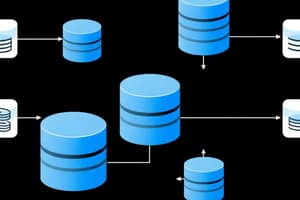Podcast
Questions and Answers
Which of the following describes the purpose of data abstraction in database systems?
Which of the following describes the purpose of data abstraction in database systems?
- To add or remove details based on the user's preferred level, highlighting key components. (correct)
- To hide the database from all users.
- To physically secure data within the database.
- To complicate the database structure for advanced users.
What is the primary role of a data model in the context of database design?
What is the primary role of a data model in the context of database design?
- To describe the structure of a database necessary to decide how abstract the database is. (correct)
- To provide a physical layout of the database hardware.
- To manipulate the data directly within the storage media.
- To encrypt the data for security purposes.
Which category of data models focuses on how users perceive data, employing concepts like entities, attributes, and relationships?
Which category of data models focuses on how users perceive data, employing concepts like entities, attributes, and relationships?
- Physical Data Models
- Conceptual (High level) Data Models (correct)
- External Data Models
- Representational Data Models
Which of the following is the best description of Representational Data Models?
Which of the following is the best description of Representational Data Models?
What is the primary focus of Physical Data Models in database design?
What is the primary focus of Physical Data Models in database design?
In the context of conceptual data models, what does an 'entity' represent?
In the context of conceptual data models, what does an 'entity' represent?
In database modeling, what is the role of an 'attribute'?
In database modeling, what is the role of an 'attribute'?
What is represented by a 'relationship' in a database model?
What is represented by a 'relationship' in a database model?
What does the term 'database schema' refer to?
What does the term 'database schema' refer to?
What does the 'database state' represent?
What does the 'database state' represent?
Which level of the Three-Schema Architecture describes the physical storage structure of the database?
Which level of the Three-Schema Architecture describes the physical storage structure of the database?
What is the role of the conceptual level in the Three-Schema Architecture?
What is the role of the conceptual level in the Three-Schema Architecture?
What does the external level of the Three-Schema Architecture primarily define?
What does the external level of the Three-Schema Architecture primarily define?
What is 'logical data independence' in the context of database systems?
What is 'logical data independence' in the context of database systems?
What does 'physical data independence' allow in a database system?
What does 'physical data independence' allow in a database system?
Which of the following is the purpose of Data Definition Language (DDL) in DBMS?
Which of the following is the purpose of Data Definition Language (DDL) in DBMS?
What is the function of Data Control Language (DCL) in a database management system?
What is the function of Data Control Language (DCL) in a database management system?
What role does Transaction Control Language (TCL) play in database management?
What role does Transaction Control Language (TCL) play in database management?
What is the primary function of Data Manipulation Language (DML)?
What is the primary function of Data Manipulation Language (DML)?
According to ACID properties, what does 'Atomicity' ensure in the context of database transactions?
According to ACID properties, what does 'Atomicity' ensure in the context of database transactions?
Flashcards
Data Abstraction
Data Abstraction
The process of adding or removing detail to highlight key components for users.
Data Model
Data Model
Describes the structure of a database, dictating its abstraction level.
Conceptual Data Models
Conceptual Data Models
Use concepts like entities, attributes and relationships. They describe how users perceive data.
Representational Data Models
Representational Data Models
Signup and view all the flashcards
Physical Data Models
Physical Data Models
Signup and view all the flashcards
Database Schema
Database Schema
Signup and view all the flashcards
Database State
Database State
Signup and view all the flashcards
Internal Level (Three-Schema)
Internal Level (Three-Schema)
Signup and view all the flashcards
Conceptual Level (Three-Schema)
Conceptual Level (Three-Schema)
Signup and view all the flashcards
External Level (Three-Schema)
External Level (Three-Schema)
Signup and view all the flashcards
Logical Data Independence
Logical Data Independence
Signup and view all the flashcards
Physical Data Independence
Physical Data Independence
Signup and view all the flashcards
DDL (Data Definition Language)
DDL (Data Definition Language)
Signup and view all the flashcards
DCL (Data Control Language)
DCL (Data Control Language)
Signup and view all the flashcards
TCL (Transaction Control Language)
TCL (Transaction Control Language)
Signup and view all the flashcards
DML (Data Manipulation Language)
DML (Data Manipulation Language)
Signup and view all the flashcards
DML (Data Manipulation Language)
DML (Data Manipulation Language)
Signup and view all the flashcards
SQL (Query Language)
SQL (Query Language)
Signup and view all the flashcards
Atomicity
Atomicity
Signup and view all the flashcards
Consistency
Consistency
Signup and view all the flashcards
Study Notes
Data Models, Schemas, and Instances
- Data abstraction involves adding or removing detail to suit a user's preferred level, highlighting key components.
- Data Models structure a database to determine its abstraction level.
Categories of Data Models
- Conceptual: Uses entities, attributes, and relationships to mirror user perception of data.
- Representational: Easily understood by end users yet aligned with computer storage organization.
- Physical: Focuses on how data is stored. The models incorporate details like record formats, orderings, and access paths on storage media.
Conceptual (High level) Data Models
- Entity: A real world object or concept.
- Attribute: Represents properties that describe entities.
- Relationship: Represents how entities are associated with each other.
Representational Data models
- Includes relational data models, network and hierarchical models, and record-based data models.
Schemas, Instances, and Database State
- Database schema describes the database using constructs.
- The database state shows the current set of instances or state of data at given time.
Three-Schema Architecture
- Internal Level: Describes the database's physical storage structure.
- Conceptual Level: Describes structure for a community of users.
- External Level: Describes the part of the database that a particular group is interested in, and hides the rest.
Data Independence
- Logical Data Independence: The ability to alter the conceptual schema without changing external schemas or application programs.
- Physical Data Independence: The ability to change the internal schema without affecting the conceptual schema.
DBMS Languages
- Data Definition Language (DDL): Identifies schema constructs and stores schema descriptions in the DBMS catalog.
- Data Control Language (DCL): Manages access control and permissions within the database.
- Transaction Control Language (TCL): Handles transactions in the database, ensuring data integrity and consistency.
- Data Manipulation Language (DML):
- High-level DML is used to specify complex database operations concisely.
- Low-level DML retrieves individual records or objects and processes them separately.
- SQL (Query Language): Used for interacting with relational databases and includes DDL, DML, DCL and TCL.
Atomic Transactions
- Atomicity (All-or-Nothing): Guarantees that all transaction operations succeed or none occur. If one part fails, the database returns to its original state.
- Consistency: Requires transactions to maintain database integrity and transition between valid states.
- Isolation: Ensures transactions do not interfere with each other, even if they run concurrently.
- Durability: Once a transaction commits successfully, its effects are permanent, even after system failure.
- The ACID principles (Atomicity, Consistency, Isolation, Durability) ensure reliability, with atomicity being fundamental.
Studying That Suits You
Use AI to generate personalized quizzes and flashcards to suit your learning preferences.

![[04/Sileru/01]](https://images.unsplash.com/photo-1511632765486-a01980e01a18?ixid=M3w0MjA4MDF8MHwxfHNlYXJjaHwyOHx8aGVhbHRoJTIwZGF0YSUyMGhlYWx0aGNhcmUlMjBkYXRhJTIwbWFuYWdlbWVudHxlbnwxfDB8fHwxNzA0MDA3MDI3fDA&ixlib=rb-4.0.3&w=300&fit=crop&h=200&q=75&fm=webp)


